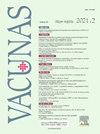2001 至 2020 年西非麻疹病毒基因型的生态分布和系统发育多样性
Q3 Medicine
引用次数: 0
摘要
导言麻疹仍然是发展中国家公共卫生的重大威胁,尤其是在 5 岁以下儿童中。根除麻疹计划的一个重要方面是对野生型病毒进行基因鉴定,以便更好地了解传播模式,为疫苗接种策略提供依据。本研究旨在利用 GenBank 现有的序列数据,调查 2001 年至 2020 年期间西非麻疹病毒的生态学和基因型多样性。此外,我们还进行了成对序列比较分析,以确定西非各种基因型的进化分化及其与疫苗株的遗传距离。结果我们的研究结果表明,在过去 20 年中,B3、D3 和 D8 分离株一直在西非各国流行。值得注意的是,B3分离株已被确定为造成地方性传播的主要因素,这一点从同一分离株同时出现在该次区域内不同国家就可见一斑。此外,我们的分析表明,D3 和 D8 分离物的循环发生了重大变化,15 年前,这些分离物最初仅在新几内亚有报道,但现在则以 B3 基因型为主。特别是在尼日利亚,B3.1 分离株目前占主导地位,这表明麻疹病毒在当地流行。然而,尽管 N450 具有信息价值,但要准确了解麻疹病毒在西非的进化动态,仍亟需完整的基因组测序数据。本文章由计算机程序翻译,如有差异,请以英文原文为准。
Ecological distribution and phylogenetic diversity of measles virus genotypes in West Africa, 2001 to 2020
Introduction
Measles remains a significant threat to public health in developing countries, particularly among children under the age of 5. A pivotal aspect of the measles eradication initiative involves the genetic characterization of wild-type viruses to better understand transmission patterns and inform vaccination strategies.
Objective
This study aims to investigate the ecology and genotype diversity of the measles virus in West Africa from 2001 to 2020, utilizing available sequence data from the GenBank.
Methodology
We conducted a comprehensive analysis using maximum-likelihood phylogenetics, focusing on the N450 fragment from measles virus isolates found in West Africa between 2001 and 2020. Additionally, pairwise sequence comparison analysis was carried out to determine the evolutionary divergence of various genotypes in West Africa and their genetic distance from vaccine strains.
Results
Our findings indicate that over the past 2 decades, B3, D3, and D8 isolates have been circulating in various West African countries. Notably, B3 isolates have been identified as the primary contributors to endemic transmission, as evidenced by the concurrent presence of the same isolate in different countries within the subregion. Furthermore, our analysis reveals a significant shift in the circulation of D3 and D8 isolates, which were originally reported exclusively in New Guinea over 15 years ago but are now dominated by the B3 genotype.
Conclusion
Over the past 2 decades, B3, D3, and D8 measles virus genotypes have circulated in 10 West African countries. Particularly, B3.1 isolates currently dominate, especially in Nigeria, indicating endemic transmission. However, despite the informative value of N450, complete genome sequencing data is highly needed to accurately understand the evolutionary dynamics of the measles virus in West Africa.
求助全文
通过发布文献求助,成功后即可免费获取论文全文。
去求助
来源期刊

Vacunas
Medicine-Infectious Diseases
CiteScore
3.90
自引率
0.00%
发文量
138
审稿时长
62 days
期刊介绍:
Sin duda una de las mejores publicaciones para conocer los avances en el campo de las vacunaciones preventivas, tanto en el ámbito de la investigación básica como aplicada y en la evaluación de programas de vacunaciones. Su alta calidad y utilidad la ha llevado a estar indexada en los prestigiosos índices IME y SCOPUS.
 求助内容:
求助内容: 应助结果提醒方式:
应助结果提醒方式:


